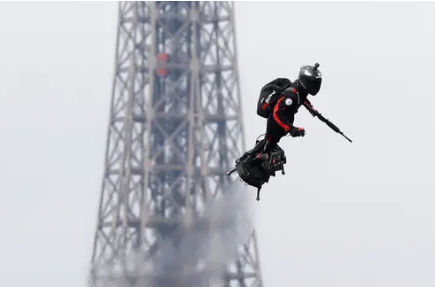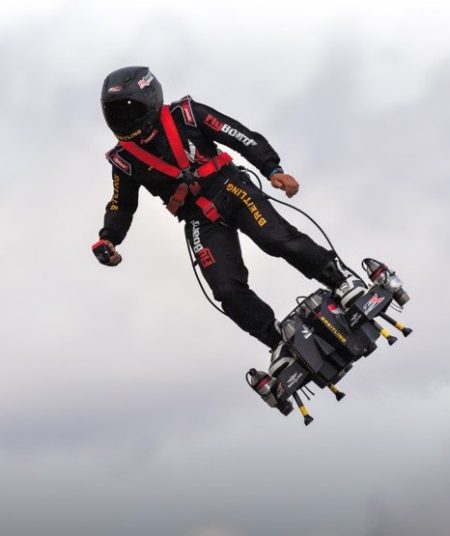July 15, 2019 – Yesterday France celebrated its annual Bastille Day, commemorating the French Revolution of 1789 and an annual rite of passage in which the French and invited nations from Europe demonstrate military technological prowess. Part of the celebration included a demonstration by French military reservist, Franky Zapata, riding a jet-powered flyboard above the crowd gathered to watch along the Champs-Élysées.

Zapata calls his invention, the Flyboard Air. a vertical takeoff and landing (VTOL) platform designed for a single passenger. Its maximum speed as demonstrated so far is 140 kilometers (87 miles) per hour, with performance specifications rated to 200 kilometers (141 miles) per hour. Maximum altitude as demonstrated so far has been 150 meters (just under 500 feet) with Zapata indicating a 3,000-meter (9,840-foot) ceiling. Demonstrated payload has been 100 kilograms (220 pounds) with predicted capacity double that.
The Flyboard Air is powered by turbine engines running on jet-fuel rated kerosene. Its multiple engines means if one should fail the Flyboard can continue to operate. To operate, Zapata claims it does not require any formal pilot training because it is designed to respond to normal human body movements and balance.
The operator wears a helmet with heads-up information displays indicating engine performance, fuel levels, altitude, and speed. All fight controls are triple redundant. And in case of an emergency water landing, the quick release boot feature separates the board from the pilot.
Zapata describes on his website the practical application of his invention beyond its entertainment, recreational and promotional uses:
- Military
- special operations
- ship-to-shore transfers
- First Responder
- emergency access for medical personnel
- rescue and recovery
- autonomous unmanned evacuation
- resupply missions
- Industrial
- infrastructure inspection
- repair platform
- specialized distribution
- security
With jet turbines as its power source, one would never call the Flyboard Air a stealth military tool. So that would limit its special operations capability. And as for ship-to-shore transfers, helicopters provide much greater capacity and speed. And as for first responder and industrial use, robotic drones are already being used to fulfill the kind of applications Zapata describes. So I am skeptical about this invention becoming much more than a recreational joy-ride for those who want to experience solo flight without wings or a kite.









